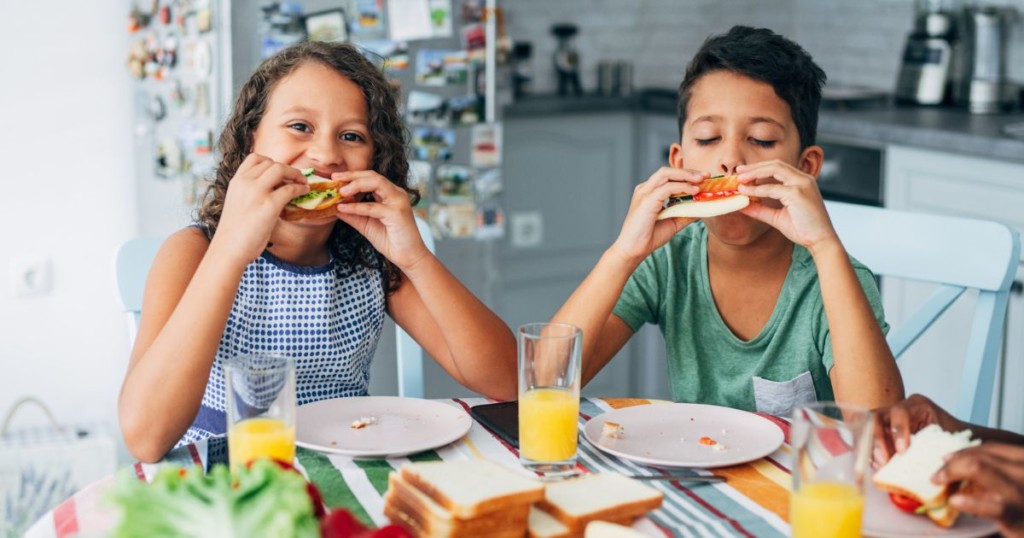Counting carbs and type 1 diabetes: FAQs

Counting carbohydrates (carbs) is one of the major parts of type 1 diabetes (T1D) management. It can feel overwhelming at first, but as you develop your confidence (and find a few good cheat sheets to make your favourites easier to carb count), it can become second nature.
Before we get started, remember this: carbs are not bad and do not need to be avoided! They’re an important part of our diet.
Read on to find answers to some popular T1D carb counting questions, including the difference between fast-acting and slow-acting carbs, systems and tools to help you, school lunches, and how to deal with a fussy eater who lives with T1D.
What are carbohydrates (carbs)?
Carbohydrates give us energy and help children grow healthy and strong. Foods with carbs include pasta, rice, cereal, grains, potatoes, corn, breads, fruit, yoghurt, milk, legumes and crackers.
When eaten, carbs break down into glucose, which is absorbed into our blood. This becomes the fuel our body needs to function well. Even in a person without T1D, blood glucose levels (BGLs) vary throughout the day as energy is consumed and used by our bodies.
Fast-acting and slow-acting carbs: what’s the difference?
Carbs aren’t all equal, as they don’t provide the same nutrients your body needs to grow and develop, or have the same effect on BGLs.
There are fast-acting and slow-acting carbs. Both raise BGLs and need to be balanced with the right amount of insulin.
Slow-acting carbs can be enjoyed as part of a healthy diet with the right amount of insulin. Some examples of these include wholegrain breads and cereals, fruit, starchy vegetables, pasta and milk.
Fast-acting carbs are important for people with T1D as they’re needed to quickly raise BGLs when experiencing hypoglycaemia (low BGLs, or a ‘hypo’). It’s a good idea to try and keep these fast-acting carbs for hypos as they have little nutritional value.
Alternatively, some fast-acting carbs, like white bread, can be enjoyed as part of a mixed meal – adding protein will dampen the quick rise.
The Glycemic Index (GI) is a measure of how quickly or slowly foods are digested and absorbed into the body. Foods with a low GI are more slowly digested and absorbed, keeping you fuller for longer and creating a slower rise in BGLs. Try to include at least one low GI food with each meal to help stabilise levels.
How many carbs should my child eat?
When a child is first diagnosed with T1D, there’s a lot of education and support given to help you become comfortable and confident counting carbs. This amount varies from child to child, and will change as they develop and grow.
Speak to your child’s support team to get a guide for you to follow.
What’s the best system for carb counting?
You may learn to count carbs in ‘exchanges’: one exchange is the equivalent of 15 grams of carbs, so if you’re eating 45 grams of carbs, that’s three exchanges. Foods that equate to one exchange include a slice of bread, a glass of milk, a medium potato, or a medium apple, banana or orange. Remember that size matters, so a larger piece of fruit or a thicker slice of bread will contain more carbs, therefore be more exchanges.
Alternatively, you may be taught to count carbs in grams. Both ways of counting can help you adjust the meal-time insulin for the carbohydrate your child is going to eat. Your child’s dietitian can provide a guide for upper and lower amounts of carb at a meal. This will change as your child grows, and can vary for different types of meals.
Regardless, you’ll learn to adjust the amount of insulin according to each meal, and to cover any extra snacks. If your child moves to using an insulin pump they’ll find they can be more flexible with their eating, giving insulin to cover varying amounts of carbs.
Do I have to weigh and measure everything?
At first it’s a good idea measure and perhaps weigh everything to get a grasp of serving sizes. (You may be better at it than you’d think!)
As time goes on you’ll find yourself weighing and measuring food less. Using the same bowls or plates helps to keep the serving sizes consistent, but go back to weighing and measuring periodically to check the accuracy of servings, particularly as your child grows and their appetite increases.
It’s recommended that you always weigh and measure foods that are high in carbs but not individually portioned – like cereal, ice cream from the tub or hot chocolate powder – to keep insulin dosing in check.
Are carbs the only foods that can affect BGLs?
All foods containing carbs convert to glucose, but fibre, protein and fat content also influence the impact on our BGLs. As your child moves further along their T1D journey you might identify the impact that fibre, protein and fat have on your child’s levels, and will be able to make some adjustments to their care.
Tip: Always remember that your diabetes team are there to help you. You can also talk to your dietitian (if you have one) for tips and advice.
How do we best manage school lunchboxes?
When packing a lunchbox for school or preschool, to help educators make sure the right amount of insulin is given, families usually include a carb list, or label each food with the carb amount.
Carb-free foods can also be labelled and included so children can eat these as extras without needing more insulin.
What do I do if my child is a fussy eater?
If you’re dealing with a fussy eater, try not to let T1D get in the way of them being offered new foods. If you find you’ve given insulin for something they’re now refusing to eat, make sure you have a little extra food set aside you know they will eat. Give them that as an alternative and try again next time.
Understanding the impact food has on BGLs is important, and you’ll find that you talk about food more than ever now that T1D is a part of your life. But remember that while it’s an important part of the T1D journey, it’s not the only focus. The most important thing is that your child enjoys a balanced diet, and is supported to develop a healthy relationship with food while managing their T1D.
Tips and tools to help with carb counting
- When your child is first diagnosed it’s a good idea to make a list of all the foods they eat regularly, along with their carb count. You can put this list on the fridge or pantry door, and save it on your phone or tablet.
- It can also be handy to create a carb cheat sheet of the family’s favourite meals. Take lasagna as an example: carb count the whole dish, then cut it up into portions and divide the total carbs by the number of portions. Now you have an easy way of remembering the carb content of a portion.
- You can use online carb calculators and apps, such as CalorieKing and the Australian Carb Counter: the Traffic Light Guide to Food.
- There are some courses you can take online to help you learn more about carbs: check out Cyber Carbs by the Type 1 Diabetes Family Centre, and Carb Counting Online by NDSS.
- Visit Diabetes NSW for a carb counting factsheet.



